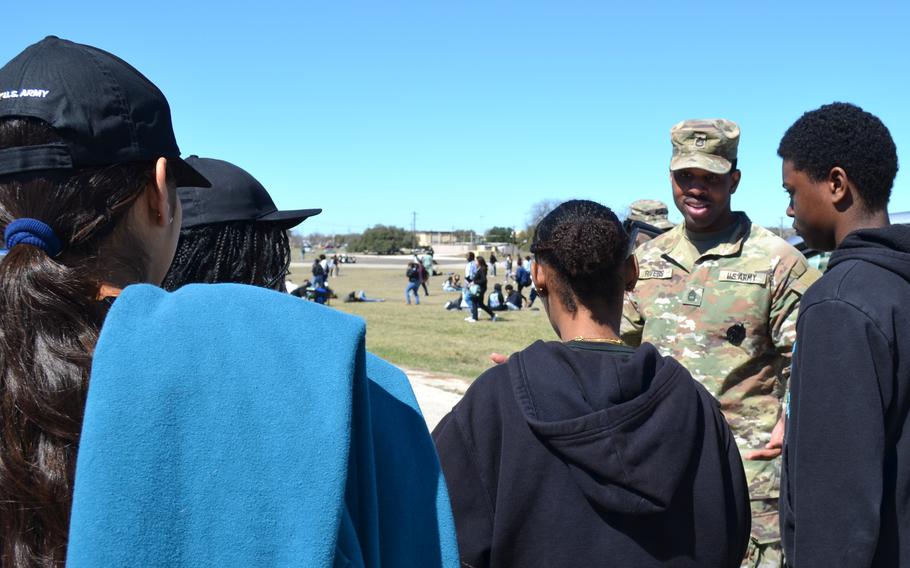
Sgt. 1st Class Kareen Rivers, an Army recruiter, speaks to high school students to a recruiting event on March 5, 2025, at Fort Cavazos, Texas. (Rose L. Thayer/Stars and Stripes)
AUSTIN, Texas — Doniel Kennedy graduated from Texas State University in 2021 with plans for a career using his degree in digital media and cinematography. He’d done some acting in TV and film and landed his first job as a videographer for a production company in Austin.
Then he got laid off.
Kennedy said he struggled to replace his full-time job with another in the same field and thought he would see whether there was a place for a visual storyteller in the Army.
“My father [and] my grandfather did 20 plus years in the Army,” he said. “I figured it could be a cool way to be a third-generation soldier. If there was a field that fit … then I’d go ahead and take that leap as well.”
Kennedy shipped off to boot camp after Christmas 2022 on a five-year enlistment and celebrated his 26th birthday in training at Fort Jackson, S.C. Now, at 27, he is a specialist assigned to Fort Carson, Colo., married and expecting his first child later this year.
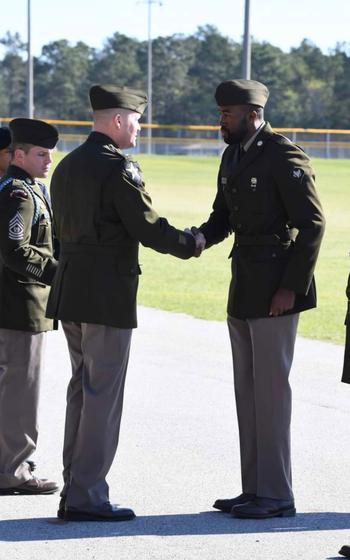
Spc. Doniel Kennedy, 27, right, receives the Soldiers Leader of the Cycle Award during his graduation from basic training in 2023 at Fort Jackson, S.C. He chose to enlist in the Army after graduating college to gain career experience. (Doniel Kennedy)
The decision to enlist has given him stability and making the choice later as an adult gave him more perspective, thicker skin and the ability to better adapt to the military environment, he said.
Kennedy’s story is part of a trend for the Army — older recruits. The average age of enlistees is slowly rising beyond 18-year-olds who just graduated high school to young adults who have had a taste of college or the job market.
When the coronavirus pandemic took hold of the United States in 2020, the Army’s average recruit was 21.4 years old. Five years later, the average age has increased to 22.7.
Meanwhile, the percentage of recruits enlisting during their senior year of high school — traditionally the bread-and-butter of military recruiting — has gone from 20.5% in 2020 to 13.1% in 2024, according to the service.
The Army began seeking out older recruits during the pandemic, said Brig. Gen. Sara Dudley, deputy commander of operations for the Army Recruiting Command.
“It pushed us out into a broader market and into deeper sections of the community that had individuals who were still [interested] but maybe weren’t getting that amount of attention from Army recruiters in the past,” she said. “As that developed and it became fruitful for us, then it’s just kind of kept on.”
Military recruiting has struggled in the five years since the pandemic began, with all the services but the Marine Corps falling into a two-year enlistment slump from which they only began to emerge in 2024. Defense officials said all the services are on track for a positive end to fiscal 2025, which ends Sept. 30.
The Army expects to meet its goal of 61,000 recruits for 2025, Dudley said.
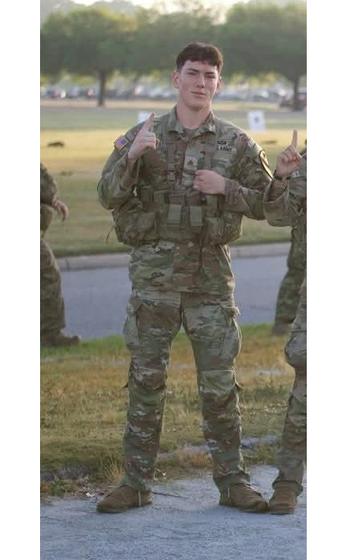
Sgt. Cody Kirkpatrick, 21, chose to enlist in the Army directly after graduating high school, a demographic that is shrinking as adults more people decide to enlist in the early to mid 20s. (U.S. Army)
Sgt. Cody Kirkpatrick, 21, was part of that shrinking number of high school seniors ready to commit to an Army career. He had the opportunity — and strong urgency from his parents — to go straight into college but said he just didn’t want to take that choice.
“I just wanted to start off serving my country,” Kirkpatrick said. “I wanted to have the military be my career. And in my eyes, the earlier I joined, the more time I have to further my career.”
Arriving at basic training more than two years ago, he said he was not expecting to see as many older trainees with him at boot camp. Now a cavalry scout at Fort Cavazos, Texas, he said there are soldiers more than five years his senior whom he outranks. Kirkpatrick said age differences have not bothered him.
“I’ve had prior work experience. When I was a ranch hand, I had a lot of older gentlemen with me ranching and roping and stuff. When I was a fry cook at Chicken Express, I [worked with] people twice my age. At the time, I was 15,” said the Blanco, Texas, native. “I can’t really say too much about it because they were all regular people just like me with the same attitude of just trying to get through it.”
But Kirkpatrick said he noticed younger trainees at boot camp had a more difficult time dealing with bouts of homesickness.
Beyond the surge
Other services, too, have seen small increases in the age of recruits but not the full year leap of the Army, according to data provided by the services. The Air Force’s and Navy’s average age of recruits has moved from 21.2 in 2020 to 21.8 years old in 2024. Airmen enlisting while in high school has held relatively steady in the past five years with about 28% making the decision to enlist as a senior.
The Marines are still enlisting the youngest recruits into the service, averaging just more than 19.5 years old in the past five years with more than 40% signing their contract and entering the delayed entry pool while a senior in high school. That is down from 46% at the start of the pandemic.
The Navy also has seen high school students taper off. In 2020, seniors made up 30% of enlistees. Last year that dropped to 21%, according to the service. This occurred because the Navy has shifted to recruiting people who can ship in months beyond the summer enlistment surge following high school graduations, said Cmdr. Stephanie Turo, spokeswoman for the Navy Recruiting Command.
“The Navy has in no way reduced its focus on high school seniors but has expanded our scope to cover a wider swath of the population in the relentless search for the very best talent,” she said.
Research on older recruits has shown they tend to perform better than their peers in basic training and their first enlistment but are more likely to have a medical waiver, said Beth Asch, senior principal economist with the Rand Corp.
“A lot of what happens in the military is very team-oriented, and maturity matters. You have to get along. You have to be able to follow instructions accurately and timely,” she said.
Parents seeking stability
In recruiting more people in their early to mid-20s, the Army has also found an increase in parents enlisting, some of whom require a waiver that proves someone can care for their child or children during boot camp and other times of separation.
The number of dependency waivers submitted for the Army has nearly doubled in five years — from 487 in 2020 to 840 in 2024. The Air Force has seen a moderate increase over the same time from 457 to 623.
The Navy has seen more parents submit waivers to enlist than the Army, despite the service pausing submissions in 2022 to review the performance of those allowed to enlist with the waiver, Turo said. No concerns were found, and waivers resumed later that year. The Navy received 889 last year — up from 724 in 2020.
Col. Lee Evans, director of market intelligence for the Army Recruiting Command, said good recruiters are tailoring their messages to appeal to those young parents looking for steady employment.
“For 17 years old or 18 years old in high school … they might be looking for adventure and excitement. If it’s someone who’s 24, 25, maybe married, maybe has a kid, two kids, then the message changes,” he said. “Maybe it is some of the other benefits, the stability, the training, the experience and things that could help them further their career.”
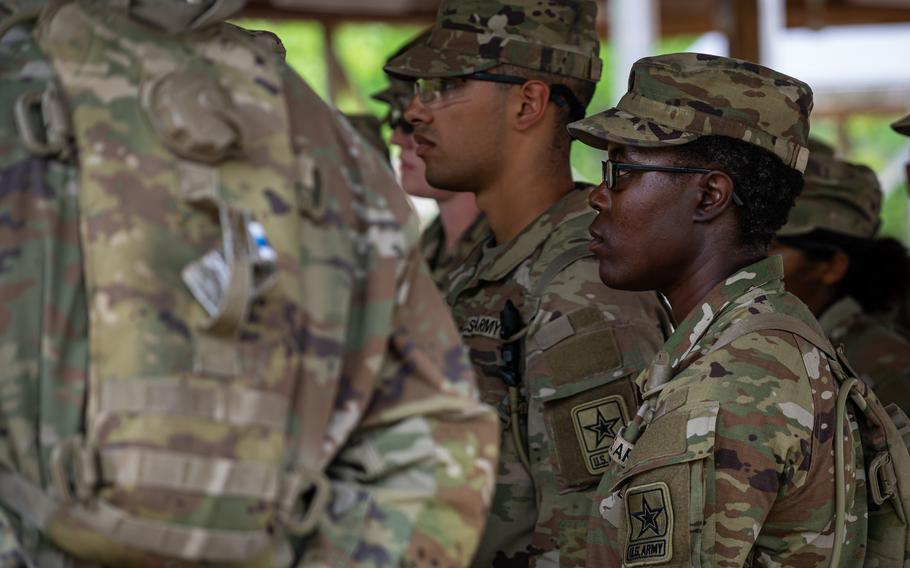
Spc. Joslin Willis, 33, a combat engineer trainee with B Company, 31st Engineer Battalion, takes part in mine detection training on May 13, 2025, at Range 33 on Fort Leonard Wood, Mo. (Jesse Gonzales/Fort Leonard Wood Public Affairs)
Spc. Joslin Willis, 33, is a mother with three children younger than 6 who decided this year to enlist in the Army. She spent eight years as a Marine, and said her husband fully supported her decision to get back into the military after a three-year hiatus. He stepped away from truck driving to be with their kids during her initial Army training.
“I just wanted a better life for my three children,” she said, taking a break from her second week of combat engineer training at Fort Leonard Wood, Mo. “It was mainly the schooling and the housing on post.”
Willis chose the Army because it has a wider selection of duty stations than the Marine Corps. After her initial training, she’s on her way to Fort Bliss, Texas.
“When I was in my 20s, I was just worried about myself. I didn’t have anybody to look after,” she said. “Now that I have a family, I have my kids looking up to me. I’m trying my best to make the right decisions.”
At kindergarten graduation, Willis said her daughter told the class she wanted to be a soldier “just like Mommy.”
“That made me tear up and feel proud,” Willis said.
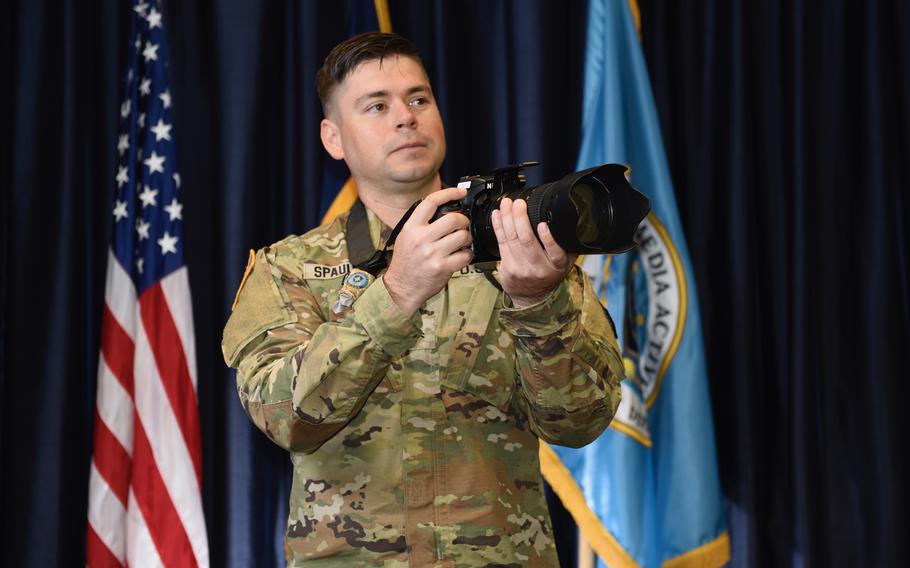
Sgt. Robert Spaulding, 40, prepares to take a photo for his job as a public affairs specialist at Fort Carson, Colo. He chose to enlist in the Army after becoming a father to better care for his children. (Robert Spaulding)
Sgt. Robert Spaulding, 40, said his family also weighed heavily in his choice to enlist a decade ago. He was separated from the mother of his two children and looking for a stable job to help him pay child support so he could continue to see his kids.
Raised in a military household, Spaulding had been avoiding the prospect of enlistment for most of his adult life. He’d grown up having to roll his clothes boot-camp style, scrubbing away any bit of grime or dirt and keeping everything in his room exactly in place.
“No matter how hard I tried, I was viewed as a deadbeat father, and in a lot of respects, I was,” he said. “[The Army] was more of an honorably viewed job that included benefits to where I could both take care of myself and my family.”
Enlisting was more of the logical choice over the right choice. In a perfect world, Spaulding would finish his engineering degree and get a career in the biomedical field.
When he reenlisted during the pandemic, he felt it was the best way to steer clear of the instability in the civilian job market. He is now assigned to Fort Carson.
A tailored approach
The Army is always adjusting its recruiting strategy to those outside factors of the U.S. labor market, Evans said. The portrayal of the Army in films, TV and by the news media also plays a part in how recruiters interact with potential enlistees.
“The most valuable tool that we have in recruiting is the recruiter on the ground because any time someone sees a bad news story or maybe it’s a good news story … about a charitable organization for veterans, people are forming opinions about what Army service entails,” he said.
An in-person recruiter can share their personal Army story, Evans said.
“That’s where we see some of the greatest successes come from in being able to adapt to the environment,” he said.
Army recruiters visit between 8,000 and 10,000 events across the country each year, said Tim Blair, deputy director for marketing at the Army Recruiting Command. That can range from large air shows to small presentations to a classroom or volunteering to coach a sports team in the community.
Though those high school seniors have tapered off — in part because more graduates go to college than did 20 years ago — Dudley said it is still important that students see a recruiter and get a familiarity with the military as early and as often as possible. It plants the idea of service, she said.
About 25% of students who started college since 2007 had not graduated by 2024, according to Rand. College enrollment peaked in 2010 at about 21 million students, according to the Department of Education. It dipped during the pandemic and is now at about 19.2 million students.
“Most of the 17- and 18-year-olds who we talk to, they’re just not sure what they want,” Dudley said. “It’s not too much for the formation to handle to talk to high schoolers and get out and find some individuals in the labor market and individuals who have had some school that maybe, life happens, and their situation didn’t work out the way that they thought it would. The Army is a great opportunity to carry on and further develop skills that they have learned.”
Kennedy didn’t set any retirement goals when he made the decision to enlist for better job experience. Right now, he said he’s enjoying the opportunity to tell visual stories for the Army. When his contract is over, he’ll reassess what is right for him and his family.
“If I’m loving it, I’ll stay in as long as I need to,” he said. “If I’m not enjoying it as much, at a minimum, I’m going to have that stability for a few years. … I’ll have five years of professional experience on top of my degree to hop back into the job market and be a lot more competitive.”